Ahwaz, in Iran’s southwest, is a city of about 1.3 million and the largest city in Khuzestan province. Close to the Iraqi border and the Persian Gulf, Ahwaz is home to Iran’s largest Arab population and several other ethic minority groups. It first prospered thousands of years ago along the banks of the Karun River, a waterway that today irrigates one of Iran’s largest food bowls.
Famous for being “birthplace of the nation” and also the epicenter of Iran’s oil industry, yet the region remains largely undiscovered by international tourists.
Thinking about adding Ahwaz to your Iran bucket-list? Read on for all our tips to get the most out of your trip!
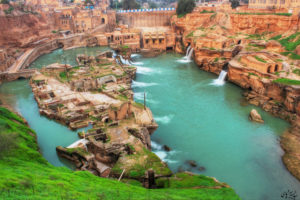
The Karun River and ancient hydraulic systems in Shushtar, Khuzestan, Iran (photo: WikiCommons)
History
Ahwaz and surrounding areas have a long history of ups and downs which stretches more than 3,000 years. Home to several World Heritage Listed sites, this region is recognized for its rich culture and ancient infrastructure.
The Elamites, an ancient people, and neighbors of the Babylonians and Sumerians are the first known occupants of what is now known as Khuzestan. The Elamites’ capital was Susa and its ruins are located an hour and a half drive from Ahwaz. Excavations of Susa were carried out by the French in the 19th and 20th centuries. Many of the artifacts from those digs are prized possessions of the Louvre and the National Museum of Iran.
After the fall of the Elamites around 500 BC, the region was taken over by the Achaemenid Persian Empire. Susa became the winter capital of the Archaemenid Kings. Following the Achaemenid period were several other Persian dynasties until the Arabs invaded in the 7th century.
The region has continuously played an important role over the millennia because of the Karun River, which provides for agricultural development. After oil reserves were discovered in the early 2oth century, Ahwaz became a world city and home to many American expats who worked in the oil industry. The Iran-Iraq War followed the Iranian revolution in 1979 and due to Ahwaz’ close proximity to the Iraqi border, the city was all but destroyed by bombings. Thirty years on, Ahwaz has been rebuilt and continues its oil production and steel industry.
In recent years Ahwaz has made international headlines regarding racial tensions between the Arab and Iranian communities. Writing for Aljazeera, Hamid Dabashi describes Ahwaz as a migrant town. Recalling his youth in Ahwaz, he writes:
In our part of the city we had an Isfahani mosque on one side and an Armenian church on the other, one catering to labour migrants from the city of Isfahan and the other to Armenian families from all of over the country. Some of my classmates spoke Arabic as their mother tongue, while others spoke their Persians with distinctly Shirazi, Dezfuli, Isfahani, or Tabrizi accents.
Ahwaz holds secrets and stories of millenniums past. The region has had its fair share of sadness, terror, and destruction. You can feel this but it is subtle in comparison to the rich culture and heritage that has developed in the region over 3,000 years.
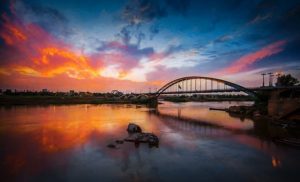
The Pol-e-Tabiet footbridge in Ahwaz, Iran (photo: WikiCommons)
Ahwaz weather
Ahwaz is a notoriously hot place. We’re talking 50+ degrees Celsius during the summer kind of hot. The first story I heard of the city was from a friend who traveled there in the summer. As he stepped off the plane onto the tarmac he felt the hot, strong breeze of the jet engines. Or so he thought. What my friend mistook for a blasting airplane engine was in fact the balmy breeze of Ahwaz.
Ahwaz’s climate is described as a subtropical hot desert climate. Unlike most of the country which is situated on the Iranian plateau, Ahwaz is only 23 meters above sea level. This makes it hotter and more humid than most places in Iran. Winters are mild and annual rainfall is a mere 230mm.
Ahwaz is lovely to visit from October through to March. If you go in summer, you can sleep during the heat of the day and stay up all night, as the locals do.
Where to go
Travelers can easily spend a few days checking out the sites around Ahwaz.
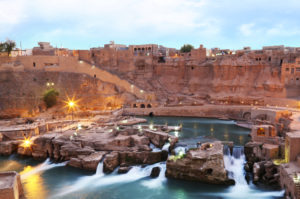
Shushtar’s hydraulic site exemplifies the sophistication of the ancient Elamite people (photo: WikiCommons).
Shushtar is a fortress city with a UNESCO listed hydraulic system dating back to 500BC. Demonstrating the engineering genius of the Elamite people, the hydraulic system creates two main diversion canals. Not only practical, but the system forms a spectacular cliff of cascading water which then gets channeled to over 40,000 ha of farmland downstream.
In ancient times the city of Shushtar was an island on the Karun River. Nowadays the city spreads well beyond. Shushtar is home to a bunch of places that will interest international visitors. Check out the Khan Garden, take a cruise of the Karun River or chill out at the Tarmeh Coffee Museum.
Located less than 1-hour drive from Ahwaz, travelers can take a day trip to Shushtar or stay the night (see below for accommodation options in Shushtar).
The city of Dezful is also worth a visit. It has a beautiful old bazaar with many stalls selling antiques and traditional handicrafts. With virtually no international tourists you can really see the real Iran in Dezful. Although only 1-hour drive from Ahwaz, Dezful enjoys a much cooler climate.
The Chogha Zanbil Ziggurat is considered to be the best preserved ziggurat in the world. Although no one knows for sure, like the pyramids of Egypt, the ziggurats are said to have been places of worship in the ancient world. Found across the Mesopotamian Valley and the Western Iranian Plateau, these ancient structures still amaze us today. The Chogha Zanbil complex comprises of the ziggurat, 13 temples, and several palaces. It is located a 1 hour drive from Ahwaz.
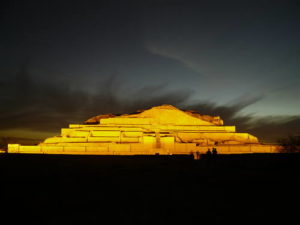
The Chogha Zanbil Complex by night, Shush, Khuzestan, Iran (photo: UNESCO)
Pol-e Tabiet, meaning “Nature Bridge” is an iconic landmark in Ahwaz. Here you can meander across the bridge and walk along with the beautiful parklands that flank the Karun River. This area is most popular at night. Local families, couples and groups of friends hang out in this area well after midnight.
Eating and drinking
Ahwaz is a large city with many Iranian and international dining options.
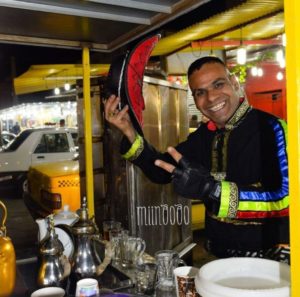
Arabic street food vendor in Lashkar Abad, Ahwaz, Iran (photo: Instagram miino0o0)
An absolute must-do is Lashkar Abad. This street in the Arab Quarter of downtown Ahwaz is a bustling hub of street food vendors and al fresco dining. Serving up delicious Arabic morsels, visitors to Lashkar Abad (sometimes jokingingly referred to as LA), can find Iran’s best falafels, samosas, baklava, and Arabic coffee.
Twenty years ago the area of Lashkar Abad was unsafe and unpleasant. But in recent years the local community have reinvented their neighborhood into the vibrant place it is today. Be sure to check out Lashkar Abad at night when all the stalls are open and the live musicians perform. As a word of warning, be prepared for the crowds!
Where to stay
The Pars Hotel is located in central Ahwaz along the bank of the Karan River. It is a five-star hotel with all the mod-cons plus some luxurious features. In typical Persian design, it’s all about wood paneling, marble, and chandeliers at the Pars Hotel. All bookings come with a free buffet breakfast and are very reasonably priced for five-star hotel. You can book Ahwaz hotels easily through 1stQuest.
Shushtar Traditional Hotel is a quaint option if you choose to stay the night in Shushtar. Built-in the Qajar era (more than 200 years ago) the hotel has been renovated and modified into a guesthouse for travelers. Within walking distance of Shushtar’s historical hydraulic system, Shushtar Traditional Hotel’s central courtyard complete with fountain and day beds is a lovely place to relax after sightseeing.
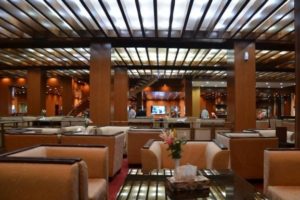
The lobby of the luxurious Pars Hotel, Ahwaz, Iran
Getting to Ahwaz
Ahwaz, being one of Iran’s biggest industrial centers, is well connected to all major airports across the country. There are several flights from Tehran to Ahwaz, starting at just €15. Check out Iran flight routes and price through 1stQuest.
Travelers can also arrive via bus. Although prices are cheaper, it will be a long journey. Ahwaz is a 7-hour drive from Shiraz and 8 hours from Isfahan. Browse Iran bus routes through 1stQuest.
